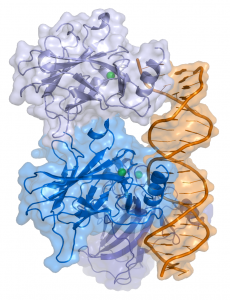The gene therapy field has seen several developments in recent months, especially around CRISPR, with both significant achievements and further controversies about the safety of the gene editing approach.
CRISPR Cure for Duchenne’s Muscular Dystrophy (DMD) in Dogs
 Eric Olson’s team of researchers at the University of Texas Southwestern’s Harmon Center for Regenerative Science and Medicine and Exonics Therapeutics, a company that Olson founded, reported in Science the use of CRISPR to restore the production of dystrophin by as much as 92% of normal levels in a dog model of DMD. Dystrophin is a protein that is key to muscle function, and mutations in the dystrophin gene are responsible for DMD.
Eric Olson’s team of researchers at the University of Texas Southwestern’s Harmon Center for Regenerative Science and Medicine and Exonics Therapeutics, a company that Olson founded, reported in Science the use of CRISPR to restore the production of dystrophin by as much as 92% of normal levels in a dog model of DMD. Dystrophin is a protein that is key to muscle function, and mutations in the dystrophin gene are responsible for DMD.
The researchers used an adeno-associated virus (AAV) vector to deliver CRISPR to an error-prone spot on exon 51, where it edited the mutation that causes the disease, repairing the gene and restoring dystrophin expression after 8 weeks in four dogs with DMD. Levels in the heart reached 92% of normal and 58% in the diaphragm; dystrophin restoration in other muscle types varied from 3% to over 50%. By comparison, Sarepta’s Exondys 51, the most recently approved DMD treatment which targets the faulty dystrophin gene, only restores dystrophin expression to 1% of normal levels in the 13% of DMD patients whose mutations are amenable to “exon 51 skipping.”
Researchers estimate that around 3,000 mutations are involved in DMD in humans. Exonics and University of Texas Southwestern collaborators are working to make CRISPR a viable approach for a broader group of DMD patients. In January, they reported on a technique called “myoediting” that enables the correction of clusters of gene mutations via exon skipping. Exonics is also working on potential treatments that target exons 44, 45 and 53, in hopes of being able to treat as many as 80% of patients with DMD.
CRISPR and Off-the-Shelf Cell Therapy
 Type 1 diabetes is caused by a defect in insulin-producing cells of the pancreas that leads to minimal or non-existent insulin production. ViaCyte is attempting to develop an off-the-shelf cure for type 1 diabetes based on turning stem cells into insulin-secreting pancreatic cells.
Type 1 diabetes is caused by a defect in insulin-producing cells of the pancreas that leads to minimal or non-existent insulin production. ViaCyte is attempting to develop an off-the-shelf cure for type 1 diabetes based on turning stem cells into insulin-secreting pancreatic cells.
In hopes that CRISPR could be used to prevent immune rejection of ViaCyte’s manufactured pancreatic cells, thus freeing transplanted patients from the need for potentially harmful immunosuppressive drugs, the company has now partnered with CRISPR Therapeutics in a deal that is initially valued at up to $25 million, including a $15 million upfront payment.
If this research leads to a development candidate, the two companies will share responsibilities for further development and, potentially, commercialization. CRISPR Therapeutics is already using the same approach to create an allogeneic approach to CAR-T.
CRISPR and Cancer: Controversies Continue
 In June, two independent publications in Nature Medicine reported that CRISPR gene editing is more likely to succeed in cells that have lost p53, a gene that normally acts as a “kill switch” to prevent cancer. The research raised concerns that CRISPR-edited cells used to treat patients might initiate tumors. These concerns have sent many scientists back to the lab to conduct their own research, and while papers have not yet reached publication, manuscripts under review are already adding to the debate.
In June, two independent publications in Nature Medicine reported that CRISPR gene editing is more likely to succeed in cells that have lost p53, a gene that normally acts as a “kill switch” to prevent cancer. The research raised concerns that CRISPR-edited cells used to treat patients might initiate tumors. These concerns have sent many scientists back to the lab to conduct their own research, and while papers have not yet reached publication, manuscripts under review are already adding to the debate.
A new computational biology study, still unpublished, supports the conclusion of the Nature Medicine papers that CRISPR Cas9 is more likely to succeed in cells that have lost p53, and further finds that such cells are also more likely to carry mutations in two other anti-cancer genes, KRAS and VHL. Researchers searched a genetic database that shows how cancer cells react to the presence or absence of various genes. In looking for genes likely to be missing in cells that already lacked functional p53, they found that cells were more likely to survive gene editing if they also lacked functional KRAS and VHL. The researchers are now running experiments in cells in an effort to confirm their computational findings.
However, another paper currently awaiting publication suggests that worries about CRISPR and cancer are overblown and that CRISPR-edited cells are not more likely to have lost p53 and become cancerous. Furthermore, according to the authors, this research employed cells more similar to those that would be used for a human therapy than the cells used in the Nature Medicine papers, which were reportedly somewhat unusual, thus increasing the relevance and impact of this study.
The debate continues. But the research suggestive of cancer risk begs a question: if CRISPR’d cells have a high probability of losing anti-cancer genes and, thus, present a risk of tumor initiation in treated patients, why has there been to date no high incidence of cancer reported in mice that have received CRISPR therapies?